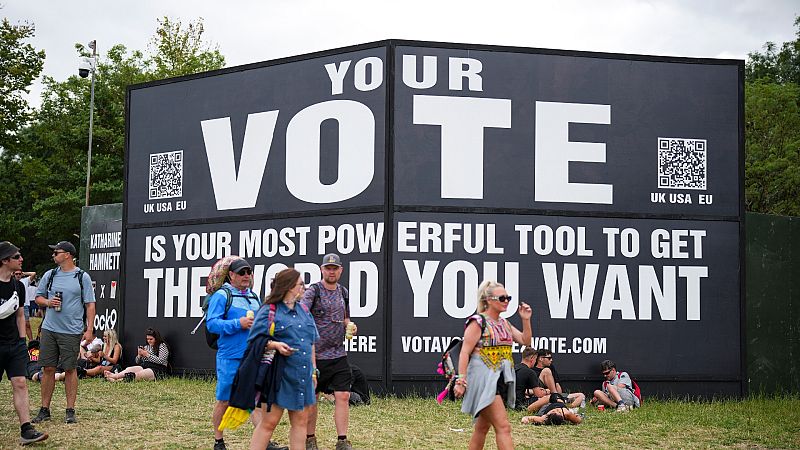
HOW GLASTONBURY HAS CHANGED OVER THE YEARS - FROM THOSE WHO REMEMBER IT
With the brunt of people arriving on Wednesday, the crowds in their thousands made their way up the hill at the Park Stage for the festival's opening ceremony fireworks.
But there was also a new addition to the rituals. As the sun set on a baking first day, people were drawn to the grounds outside the Pyramid Stage for a drone show.
A huge number of synchronised drones moved effortlessly through the sky, conjuring multicoloured images of the Pyramid, the Glastonbury sign and other classic imagery from the festival.
Set to a silent background, the effect is impressive if a little subdued. You might marvel at the technology but you aren't exactly wowed. It's all too tame and is reminiscent of a fancy LED display more than a spectacle.
Thankfully, up on the hill the fireworks start soon after and remind everyone why cascading colourful explosions can't be beat. And anyone worrying the drone budget ate into the firework one had their fears allayed by the sheer number of screamers they set off. In the adjoining field, a dragon effigy burnt as the festival kicked off.
Glastonbury as a political act
Chris Church was there at the very first event in 1970. He was 16 and attending a boarding school 10 miles up the road when a journalist offered him a lift to the farmyard car park.
Chris has come to Glastonbury almost every year ever since. These days, he comes side-by-side with Steve Wade, the CEO and managing director of Wind & Sun, a green energy charity that was founded in 1984 and has attended Glastonbury since 1986 proving that you can power stage lighting and PA equipment with wind and solar power alone.
I spoke to both of them from their Wind & Sun stall in Croissant Neuf, part of the Green Fields area that houses the festival’s environmentally focused events and stalls.
To Chris and Steve, Glastonbury’s greatest tradition is its political intent. They both originally started working as part of the festival’s Campaign for Nuclear Disarmament (CND), which became inextricably tied to the event after 1981.
“The high point of the politics probably was the 80s,” Chris says. As the pair moved from CND to Water & Sun, they found most people who approached their stall were interested in the new technologies they were exhibiting. “It was really interesting,” Steve recalls. “To be honest, the question we most get offered is, can I charge my phone?”
Chris notes that as ticket prices have gone up and the process for getting tickets has become more difficult, fewer green minded people come proportionally. “So we're getting much more of a general youthful audience rather than a politically motivated one,” he says.
Although the crowd is younger and maybe a tad more middle class than it was in the 80s, it doesn’t mean that the mind-bending experience has truly changed though, Steve says. Chris brought his daughter along to the festival for the first time last year and he saw just how impactful it can be on fresh eyes.
“Coming to Glastonbury now is a rite of passage for young people. Hopefully, that's part of their political consciousness emerging,” he says.
A place for wellness
Next door in the Healing Fields, an area dedicated to physical and mental wellbeing, Gill Jackman runs counselling sessions for festival goers. She’s been coming to Glastonbury since 1979 and attended throughout the 80s before she started working in the Welfare area in 1997.
Gill remembers the anarchy of the 80s fondly, when the festival was a more rough and tumble affair compared to the slickly run massive event of today. During the late 90s, she saw how the thousands of fence-jumpers who got into the site without a ticket added chaos to the situation.
“Welfare was absolutely packed out,” she recalls. There were generally two camps: the poor ticket owners who’d been left out in the mud and rain after their stuff had been nicked by fence-jumpers, and “people who’d stayed up for four days in the dance tent going psychotic on drugs.”
“It was good fun!” she says, always jumping at the challenge.
When the fence went up in 2002 after 2000 had a historically overburdened event, the challenge calmed down a bit and Gill started to look toward bringing her psychotherapy experience to the festival.
Today, she spends a lot of time helping young people get through their anxious responses to the overwhelming nature of the festival.
“They come expecting a fantastic time and when they get here, they're really anxious, there's loads of people, they don't feel orientated, they argue with their friends, or they get in some kind of difficult competition,” she says.
Luckily Gill, the welfare team and everyone in the Healing Fields on hand to help them through it. “Anxiety is in your body, and the short term work with anxiety can be quite easy,” Gill says. She’s had some people running around shouting and stomping to get past that initial shock to the unbelievable scale of the festival.
While the hippy movement that first formed the festival in the 70s feels long gone, the ethos of introducing people to the joys of mindfulness through spiritual and physical workshops is alive and well.
“I talk to young people here all the time and quite often they’ve never thought about these things before. Outside of this, everyone’s entrenched in their individualism, not questioning the greed and the profit and the mess,” she says.
“But here, we get to shout back at that,” Gill says.
2024-06-28T07:33:50Z dg43tfdfdgfd